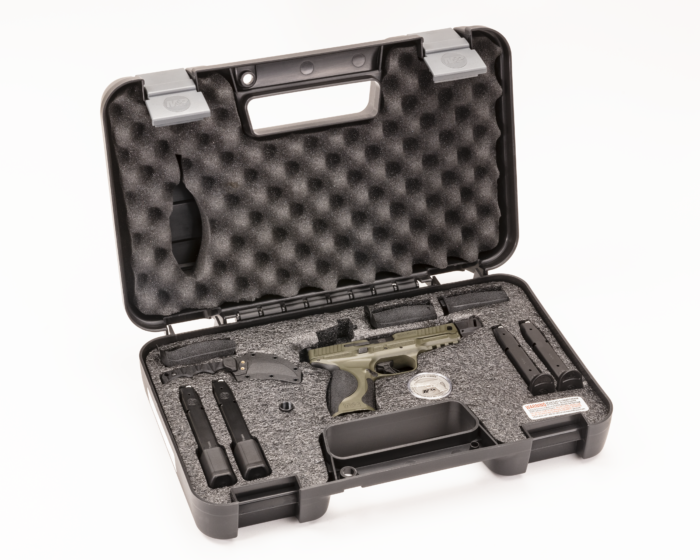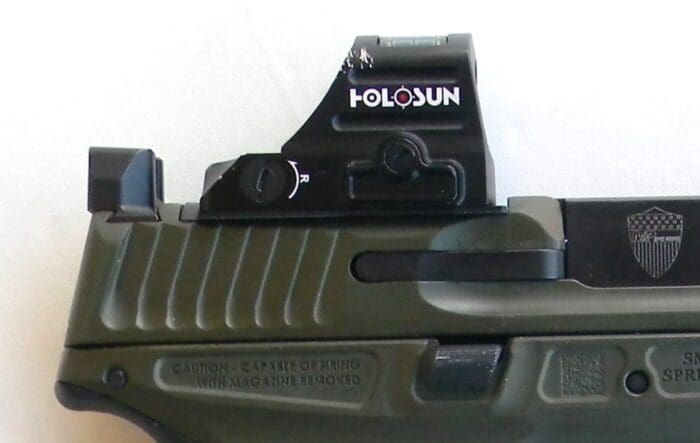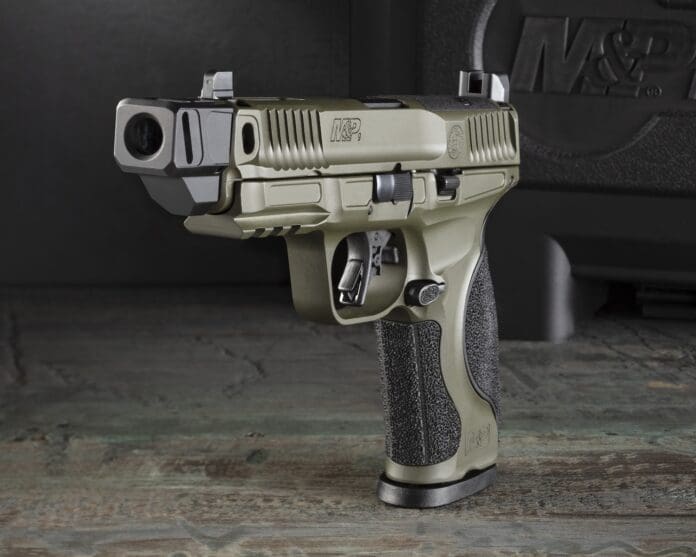Polymer frame striker-fired handguns are affordable, lightweight and reliable in most models. But striker-fired guns don’t have to be made of affordable polymer at all times. There is room for metal frames in order to improve fit and feel and heft. Smith & Wesson’s Military & Police 9mm is one of these guns and offers superior ergonomics with a trigger that in the new 2.0 version is greatly improved.
The pistol was introduced with an optional aluminum frame some months back and is more expensive to be certain and not for everyone. But then it isn’t meant to be. In my opinion, an even better pistol is their M&P Performance Center SPEC. This is an ultra-version of the metal frame M&P.
First Look
The primary difference in the S&W M&P Performance Center SPEC is the Faxon compensator that comes on the gun. It isn’t an internal compensator as seen on some SIG types but an external compensator. It is removeable. S&W supplies a thread cover in the huge hard case the pistol is delivered with. But it isn’t going anywhere unless you heat the Loctite holding it on. I’m enjoying firing it too much to remove the compensator. Though the threads would work great for a suppressor.

The pistol is delivered in a hard-sided case along with a challenge coin, a Karambit knife that is pretty neat, the usual manual and a gun lock. But the best thing is that the pistol is supplied with two 17-round and two 23-round magazines. These are the same magazines used in the S&W FPC carbine, which is great if you’re shooting one of those too and can interchange mags. While the flush fit magazines are best for concealed carry, the extended magazines are not too large to be carried in a sturdy magazine carrier properly attached to the belt.
The frame of the SPEC is aluminum and provides good overall balance to the gun. Polymer frame guns tend to be a little slide heavy, but the aluminum S&W SPEC is well balanced with a good natural line of sight. The pistol comes with three-dot night sights that make target acquisition quick and easy.
The pistol features the S&W CORE system for optics mounting. This is among the most versatile and trouble-free optics mounting systems ever designed. It works well and is supplied with a range of plates. I mounted a Holosun RDS on mine for evaluation. As expected, the pistol performed well with the red dot. Honestly, the line of sight of the new metal frame M&P seems better suited for RDS use than the polymer-frame versions, simply because the added weight of the sight adds to the already slide-heavy tendency of polymer guns.

The SPEC feels great in the hand though I know that is subjective. I had several shooters I know see how it felt to them and the general consensus was that the hand fit was very good and the pistol seems to fit most shooters hands just fine as it comes. For those who want to play with the fit, the SPEC does come with grip inserts.
The fit and finish of the SPEC are good as well by any standard. The barrel to slide fit is tight enough, and the forward cocking serrations on the slide are not overly pronounced but work just fine in practice. Meanwhile, the controls—slide lock and magazine release—are all positive in operation. Breaking the gun down is easily accomplished by turning the takedown lever down. Overall, the Performance Center SPEC is a good set up that reflects quality manufacture.
Holding the gun, the trigger breaks at 5.5 pounds—crisper than the Glock and with a sharper reset. I dry fired the gun to the tune of more than 200 striker drops before actually firing the first round.
The pistol is superior to most that cost less—no surprise there—and lists for $999, though I have seen some in the store going for $880 or so. But how does it shoot?
Range Time
I collected a good mix of ammunition to compare and contrast the pistol to other similar 9mm handguns. Some of this was ball ammunition including Black Hills Ammunition 115-grain FMJ. In testing, I drew the SPEC from a Galco belt slide. With its compensator, the SPEC fits some holsters made for the S&W M&P, but some it will not. If you have an open bottom holster, the compensator may work with it okay, but check yours to be sure before trying to carry it as it could prove to be too chunky to push through the end or be drawn smoothly.

Once I got to shooting, the SPEC proved to be fast on target and quite controllable during rapid fire. The S&W SPEC is simply fast, very fast, and really allows a trained shooter to eat a target’s center to pieces. The pistol’s felt recoil is light, but then this isn’t a light pistol, which aids in the overall handling by mitigating some of the recoil.
Moving to +P loads, I loaded the Black Hills Honey Badger 100-grain +P and the powerful 124-grain +P. This is where the compensator came into play most efficiently. With the compensator, the +P loads felt no hotter than a standard velocity FMJ. But then those of you familiar with Faxon compensators won’t be surprised at this and understand how well they shoot.
Of course, I did the obligatory 25-yard firing test. Typically, with service-grade 9mm handguns, I fire a five-shot group at only 15 yards, but this S&W SPEC is plenty accurate for 25-yard fire. I settled into an MTM Caseguard K-Zone firing rest and took every advantage for accuracy. I fired slowly, carefully pressing the trigger and taking care with sight alignment and sight picture. The results were good to excellent.
25-yard Benchrest Group
Load 5-shot group
Black Hills Ammunition
100-gr. Honey Badger +P 2.2 in.
115-gr. FMJ 2.5 in.
115-gr. EXP 1.6 in.
124-gr. JHP 1.9 in .
124-gr. JHP +P 2.0 in
Final Thoughts
The S&W M&P Performance Center SPEC is a great addition to the company’s famed M&P line and one that will certainly find its share of fans despite the slightly higher price than the typical assortment of striker-fired polymer guns available today. This one is definitely a keeper in my book.
Ratings
Reliability *****
Accuracy *****
Fit and finish *****
Concealed carry **** This is no compact. If you carry a Glock 17 or Walther full-size PPQ, the S&W SPEC isn’t any problem. It weighs a mere 30 ounces despite being larger than most typical carry guns, so the weight won’t be an issue. If carrying a full-size pistol is your thing, and you prefer to fire +P loads, then this gun is a docile sweet shooting pistol you’ll love. As a SHTF or survival gun, whatever that is, you could do a lot worse. Mount a combat light to the front and deploy the 23-round magazine, and you will be well armed.
S&W M&P Performance Center SPEC Specifications
Length: 8.5 in.
Height: 5.5 in.
Width: 1.3 in.
Weight: 30 oz.
Caliber: 9MM
Size: Full
Capacity: 23
Action: Striker Fired
Barrel Length: 4.8 in.
Grip: Aluminum
Sights: Three-Dot Night Sights
Optic Ready: Yes
Safety: No Thumb Safety
Color/Finish: OD Green
Barrel: Threaded with Faxon Compensator
Frame: Aluminum
Magazines: 4
Check out Ammo To Go, the ammunition retail sponsor of TTAG gun reviews. Get your bulk and quality ammo for a bargain by visiting their site.





Well I can not get this gunm because I am not military nor police.
Maybe with a badge and a uniform I could fake it?
Just don’t say anything and they will assume you are a secret agent and just do the background check on your “cover” I’d.
Possum 009 inches. License to eat roadkill.
The “M&P” (aka ‘Military and Police’) doesn’t mean just for ‘Military and Police’. Its also (e.g. the S&W M&P Metal Performance Center SPEC) not a market specific series, its (e.g. the S&W M&P Metal Performance Center SPEC) for any one that can buy and legally own one of these.
Basically; In 1899, the United States military was modernizing their weaponry. Part of that modernization included the Smith & Wesson .38 Hand Ejector Model of 1899. To capture and keep that market and to appeal to police also, because these were not normally considering S&W but rather Colt, Smith & Wesson wisely changed the name of the .38 Hand Ejector Model of 1899 to the .38 Military and Police model to appeal to those groups to capture another market segment. And thus the ‘M&P’ brand was born.
The ‘M&P’ is just basically a marketing brand term.
In spite of my aversion to DA only pistols, I must confess that it is an improvement over the Smith and Wesson, plastic fantastic, Smegma, I mean Sigma
I had a Sigma ve. Never gave a problem. I gave to a person that needed a gun during the scandemic and I know it still works fine.
Magazines are way too costly for a sub 300 dollar gun and that trigger takes some getting used to. But it works.
The M&P has been an upgrade from the Sigma for 20 years. The Sigma also has also been a top performing budget choice since it was redone in the mid 2000’s into a quality choice.
I had a Sigma pistol. It never had any issues. I gave it to someone who needed a gun during the pandemic, and I’m sure it still works fine.
Please explain how comments on the SIGMA are relevant to S&W’s newest handgun.
The M&P is a new truck the SIGMA was a Model T of polymer. This is the S&W M&P Gen 2, 2.0, must I repeat!!!
I want to see S&W resurrect their Gen 3 semiautos- 3913 or 3913NLS. With modified grip frame to accept M&P Compact mags.
Why not?
I suspect it’s a camera perspective thing, but the comp in the lead pic appears to be rotated a couple degrees off.
In Atlanta this weekend, and getting through.
A comp will make any gun shoot better; especially as the ammo gets hotter.
TW
zero chance of a new da first shot pistol from any of the major makers.
Well, it wouldn’t exactly be new…
Comments are closed.